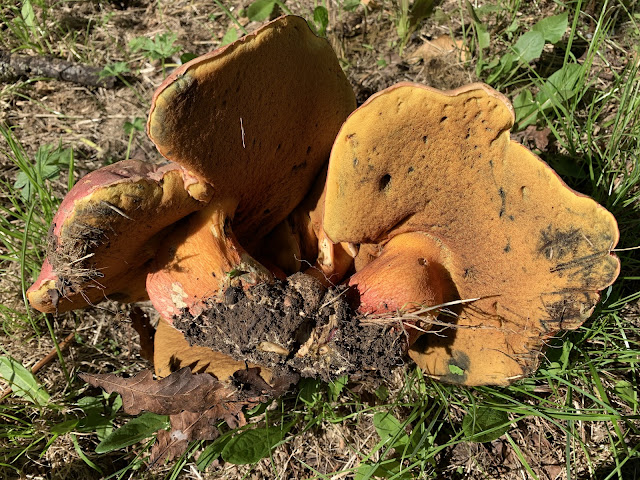The most dangerous bolete in Europe, in the palm of my hand!
Warwick University is a surprisingly good location for fungi, particularly rare thermophilious boletes. In a crazy 2022 year for fungi, I found a ghost bolete from here as well as over 600 saffron milkcaps and false saffron milkcaps in a single day, in a single area- more than I have found anywhere else combined. This summer, a bolete from the UK red list returned to Warwick.
I'll start by introducing a bolete which I wanted to find since 2009, when I got my hands on R. Phillips' guide to the fungi of Britain. Ever since I saw photos of a sectioned Boletus legaliae, as it was then known, I decided I needed to find it at all costs. But it eluded me. Until finally, in 2022, I, when stubbornly refusing to leave Windsor until I found it, found a group of 3 growing near a farm. I never saw them there again.
Rubroboletus legaliae, known as the bilious bolete and known by me as the villainous bolete, is what I consider to be the most dangerous bolete in Europe. Not the most poisonous, that 'distinction' goes to the stunningly beautiful and even more elusive devil's bolete. But the most dangerous. This fungus is villainous because it is astonishingly variable, and has a nasty habit of bearing a high resemblance to edible boletes! And this bolete decided to pay Warwick University a visit. In swarms.
The normal villainous bolete is a beautiful fungus with a white-pink cap, red pores and a distinctive red net on the stem. When cut open, it typically bruises slowly from pale lemon flesh to a light blue colour, but unfortunately I have seen this vary.
And that is where the confusion comes in. Last year, when on the way to see an orchid called the violet helleborine in Suffolk, I got distracted when chasing another type of bolete and found a cluster of villainous boletes on the side of arable land!
I have never seen these boletes with such a rich cap colour, and before I checked the stem, I was reasonably sure that it was the Pretender, Butyriboletus fuscoroseus, extremely rare in the UK. One of these mushrooms, however, had a complete lack of any sort of net on the stem! Just a pure yellow stem!
If this fungus had yellow pores as well (see below), I would have misidentified it as B. fuscoroseus. Rare boletes are usually safe from being collected by me, but had I chosen to eat it afterwards, I would have likely had a very unpleasant evening. Another deceptive trait this bolete has is variable pore colour. Unusual villainous boletes with yellow pores resulted in these boletes being misidentified as B. fuscoroseus for several years at Windsor Great Park, and highly likely resulted in a lot of mushroom poisoning cases. I myself found such a bolete there in 2022 and believed they only occurred there. Before I found one at Warwick in 2023.
Rich cap colours, yellow pores, and a reticulum that is difficult to discern. The only thing truly distinguishing this from the Pretender is the different bruising response when cut! In 2024, I found another few with orange-yellow pores, one with yellow pores, spoilt with just a hint of orange, and then a massive cluster of enormous villainous boletes in a different location, the last of which looked eerily similar to the bolete in Marren (2000), which he misidentified with the Pretender.
The latter were particularly amusing as they had fused into an amorphous monstrosity by growing too close together.Jokes aside, there is another bolete in the UK with an unpleasant name- the deceiving bolete. Normally a stunningly beautiful orange cap colour, best identified by the lack of any net on the stem and intense rhubarb red in the stem base when cut. This was the first year I have ever seen it.
That won't poison you if you cook it properly, but still best left alone. The villainous bolete, on the other hand, is poisonous in all forms, even when cooked. This is definitely a bolete to avoid eating, but, conversely, a bolete to definitely take a lot of photos of, as it is in my opinion one of the prettiest of them all.
Traditionally, this was regarded as a rare to very rare bolete of warm old woods in Southern England. However, in 2023, they exploded everywhere, and 2024 continued that trend. This is definitely a bolete to be very familiar with and be very wary of if you decide to bring home a bag full of Pretenders to eat!
However, this is also one of my personal favourites, both due to its beauty and variability.
















Comments
Post a Comment